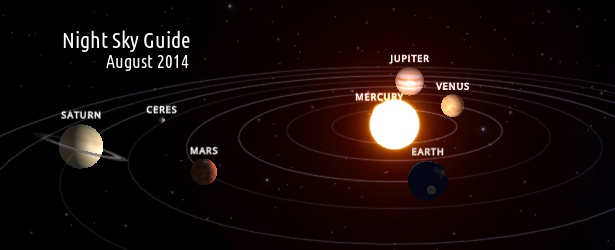Night sky guide for August 2014

Late July and early August can be one of the best times of the year to observe meteors, weather permitted. This is because there are several minor meteor showers emanating from the adjacent constellations of Capricornus and Aquarius. However, the closest and the largest full Moon of the year – supermoon – will rise on the night of August 10 and will certainly block some of them. The same goes for the mother of all Northern Hemisphere meteor showers – Perseids – which is just 12 days away.
General meteor activity rapidly slows down during the last half of August and this leads into a relatively dull period from September to the first half of October.
-
August 3 – Mars and Moon conjunction. The Moon and Mars will make a close approach, passing within 2°09' of each other. At the moment of closest approach, the Moon will be at mag -11.7, and Mars at mag -0.0, both in the constellation Virgo. The pair will be too widely separated to fit within the field of view of a telescope, but will be visible to the naked eye or through a pair of binoculars.
-
August 4 – Occultation of Saturn by the Moon. The Moon will pass in front of Saturn. At the moment of closest approach, the Moon will be at mag -12.0, and Saturn at mag 1.0, both in the constellation Libra. At closest approach, the pair will be close enough to fit comfortably within the field of view of a telescope, but will also be visible to the naked eye or a through pair of binoculars.
-
August 10 – Full Moon – Supermoon. The Moon will be directly opposite the Earth from the Sun and will be fully illuminated as seen from Earth. This phase occurs at 18:09 UTC. This full moon was known by early Native American tribes as the Full Sturgeon Moon because the large sturgeon fish of the Great Lakes and other major lakes were more easily caught at this time of year. This moon has also been known as the Green Corn Moon and the Grain Moon. This is also the closest and largest full Moon of the year, an annual event that has come to be known as a "supermoon".
-
August 12, 13 – Perseids meteor shower. The Perseids is one of the best meteor showers to observe, producing up to 60 meteors per hour at its peak. It is produced by comet Swift-Tuttle, which was discovered in 1862. The Perseids are famous for producing a large number of bright meteors. The shower runs annually from July 17 to August 24. It peaks this year on the night of August 12 and the morning of August 13. The waning gibbous moon will block out some of the meteors this year, but the Perseids are so bright and numerous that it should still be a good show. Best viewing will be from a dark location after midnight. Meteors will radiate from the constellation Perseus, but can appear anywhere in the sky. As seen from south of the equator, meteor rates associated with this shower are still decent but are falling rapidly.
-
August 17/18 – Kappa Cygnid meteor shower peaks around August 17 and 18, and produces 2 – 4 meteors per hour. With an entry velocity of 23 km/s most of these meteors will appear to travel slower than average. The radiant is best placed near 2300 LDT (11pm LDT) when it lies nearly overhead for much of the Northern Hemisphere. Due to its high northern declination this activity is not well seen from the southern hemisphere. Despite the low rates seen from this source, this shower is known to be a producer of fireball class meteors.
-
August 18 – Conjunction of Venus and Jupiter. Conjunctions are rare events where two or more objects will appear extremely close together in the night sky. The two bright planets will come unusually close to each other, only a quarter of a degree, in the early morning sky. Also, the beehive cluster in the constellation Cancer will be only 1 degree away. This rare, double-planet event is definitely one not to miss. Look for the bright planets in the east just before sunrise.
-
August 25 – New Moon. The Moon will be directly between the Earth and the Sun and will not be visible from Earth. This phase occurs at 14:13 UTC. This is the best time of the month to observe faint objects such as galaxies and star clusters because there is no moonlight to interfere.
-
August 29 – Neptune at Opposition. The blue giant planet will be at its closest approach to Earth and its face will be fully illuminated by the Sun. This is the best time to view and photograph Neptune. Due to its extreme distance from Earth, it will only appear as a tiny blue dot in all but the most powerful telescopes.
-
August 31 – Mars, Saturn and Moon will form a tripple conjunction and share a small patch of sky.

Video courtesy of Hubble Space Telescope
Sources: AMS, In The Sky, Sea Sky
Featured image: Solar System Scope, The Watchers

Commenting rules and guidelines
We value the thoughts and opinions of our readers and welcome healthy discussions on our website. In order to maintain a respectful and positive community, we ask that all commenters follow these rules:
We reserve the right to remove any comments that violate these rules. By commenting on our website, you agree to abide by these guidelines. Thank you for helping to create a positive and welcoming environment for all.